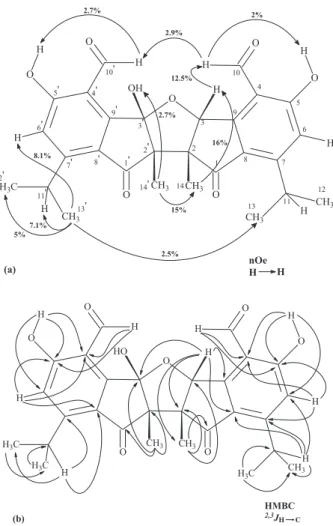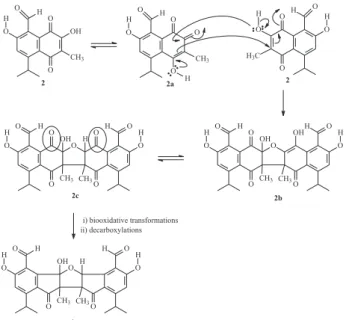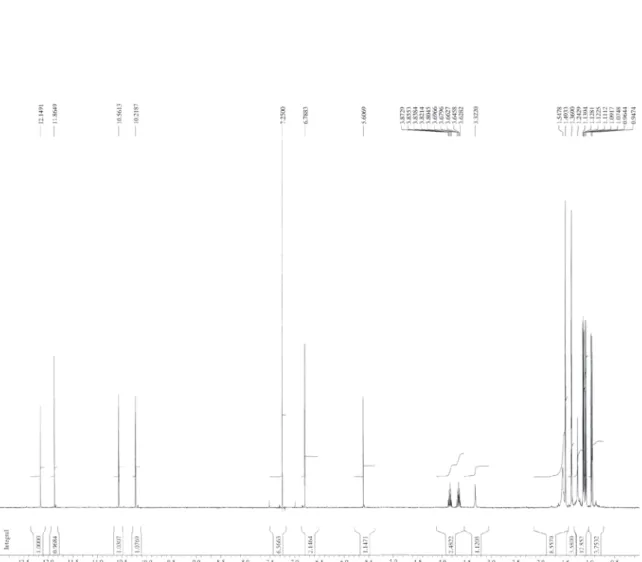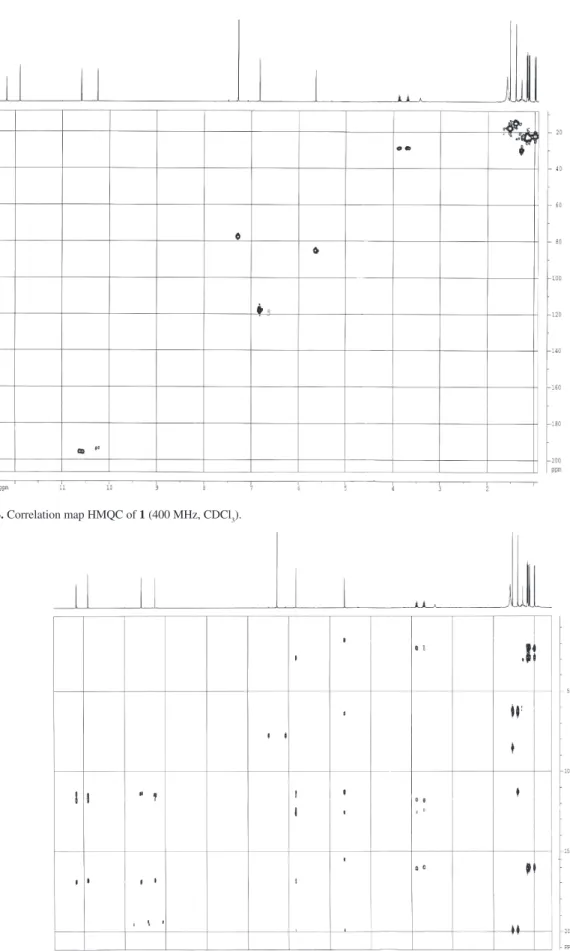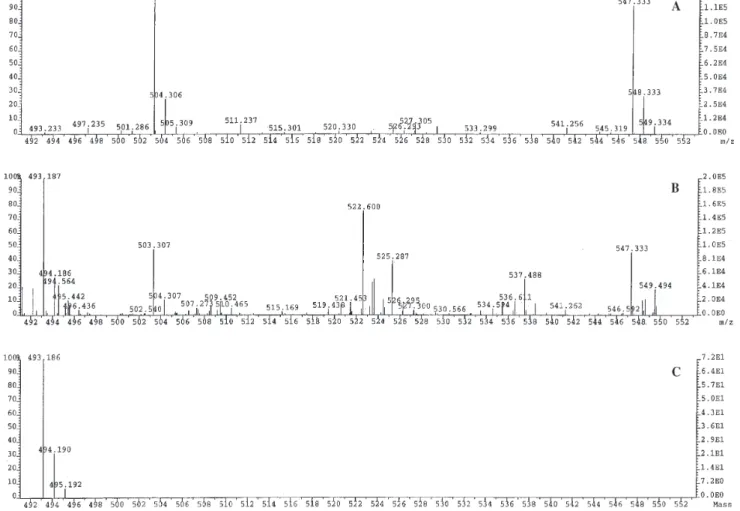0103 - 5053 $6.00+0.00
Short Report
*e-mail: vfpaula@uesb.br
Aquatidial, a New bis-Norsesquiterpenoid from
Pachira aquatica
Aubl.
Vanderlúcia F. Paula,*,a Marcelo E. Rocha,a Luiz Cláudio de A. Barbosab and Oliver W. Howarthc
a
Departamento de Química e Exatas, Universidade Estadual do Sudoeste da Bahia, Campus de Jequié, 45206-510 Jequié-BA, Brazil
b
Departamento de Química, Universidade Federal de Viçosa, 36571-000 Viçosa-MG, Brazil c
Department of Chemistry, University of Warwick, Coventry, CV4 7AL, UK
Aquatidial, um novo bis-norsesquiterpenóide assimétrico, hipoteticamente derivado da isoemigossipolona, foi isolado da casca externa das raízes de Pachira aquatica (Bombacaceae), juntamente com os compostos conhecidos isoemigossipolona, p-cumarato de triacontila e lupeol. As estruturas do aquatidial e dos demais compostos foram determinadas por análises espectroscópicas (EM-FAB, IV, RMN 1D e 2D) ou por comparação com dados publicados na literatura.
Aquatidial, a new asymmetric bis-norsesquiterpenoid, hypothetically derived from isohemigossypolone, was isolated from the outer bark of Pachira aquatica (Bombacaceae) roots, along with the known compounds isohemigossypolone, triacontyl p-coumarate and lupeol. The structures of aquatidial and the known compounds were established by spectroscopic analyses (HRFABMS, IR, 1D and 2D NMR) or comparison with published data from literature.
Keywords: Pachira aquatica Aubl., Bombacaceae, bis-norsesquiterpenoid, aquatidial
Introduction
Plants belonging to the Order Malvales, specially those from the Bombacaceae1-12and Malvaceae families,13-15
have proved to be a rich source of naphthoquinone and/or naphtol sesquiterpenes with cadalene and cadinane skeletons. The Bombacaceae family is relatively small, consisting of approximately 28 genera with 200 species and is widely distributed throughout tropical regions.16,17
The genus Pachira has two species, P. aquatica and P. macrocarpa.8 P. aquatica Aubl. known in Brazil as
“castanha-do-Maranhão”, is found in the Amazon region and in the Maranhão State.18
A phytochemical study of P. aquatica9 resulted in the
isolation of three fungitoxic naphthoquinones from the outer bark of the swollen trunk of infected plant specimens. Following our investigation on plants from Bombacaceae family,19 we have examined Brazilian specimens of P.
aquatica, collected near the Ilhéus-Itabuna highway, Bahia State. In this paper we report the isolation and structural elucidation of aquatidial (1), a new compound structurally
related to a cadalene sesquiterpene, with an unusual skeleton, hypothetically derived from isohemigossypolone (2). We also report the isolation of the known compounds isohemigossypolone (2) triacontyl p-coumarate (3) and lupeol (4).
Results and Discussion
1444 Aquatidial, a New Bis-Norsesquiterpenoid J. Braz. Chem. Soc.
C28H28O8 by 13C NMR, and by a HRFABMS (3-NBA + TFA)
spectrum that showed a peak at m/z 493.1866, assigned to [M+ H]+. The IR spectrum showed absorption bands at 3427
and 3324 cm-1 (ν OH), at 1711 and 1658 cm-1 (ν C=O). The 1H NMR signals at δ 10.56 and 10.22 (both 1H, s), were
correlated with the 13C NMR signals at δ 195.5 and 193.7 by
HMQC, indicating the presence of two aldehyde groups in the molecule. The 1H NMR signals at δ 12.15 and 11.86
(both 1H, s), confirmed the presence of two hydroxyl phenolic groups, both associated by H-bonding. The characteristic 1H
NMR signals at δ 3.84 and 3.66 (both 1H, hept), δ 1.13, 1.11, 1.08 and 0.95 (all 3H, d), were correlated by HMQC with the 13C NMR signals at δ 29.0 and 28.9 (2 x CH) and δ
23.6, 23.2, 22.3 and 21.9 (4 x CH3), respectively, suggesting the presence of two isopropyl groups. The signal at δ 6.79 (2H, s) characteristic of two aromatic hydrogens, revealed the presence of two penta-substituted aromatic rings, constituted by the 1-formyl-2-hydroxy-4-isopropyl-5,6-substituted unit, as observed in the structure of isohemigossypolone (2).9 The approximate pairing of most
of the 1H NMR signals, except those at δ 5.61 and 3.32 (both
1H, s), suggested that compound 1 contained two similar units, plus a short, unsymmetrical linking section. Two 1H
signals at δ 1.49 and 1.37 (both 3H, s) indicated the presence of two extra methyl groups.
Besides the 20 carbon signals corresponding to two 1-formyl-2-hydroxy-4-isopropyl-5,6-substituted systems, the
13C NMR spectrum also showed another eight signals. From
the Pendant spectrum these signals were found to arise from: two methyl groups (δ 17.9 and 15.0), five non-hydrogenated carbons and one CH (δ 85.2). Of the five signals correlated to non-hydrogenated carbon atoms, two were characteristic of conjugated ketone groups (δ 199.2 and 199.0); two were assigned to quaternary carbons α to carbonyl groups (C-2
and C-2’, at δ 64.0 and 61.4, respectively); and one corresponding to the hemicetal carbon C-3’ (δ 112.8). The HMQC correlations allowed unambiguous 1H and 13C NMR
assignments. The signal at δ 3.32 was assigned to a third hydroxyl group, as it was not correlated with any 13C signal.
Finally, the structure of compound 1 was completely established by correlations observed from nOe-difference and HMBC experiments (see Figures 1a and 1b), and was trivially named aquatidial. The relative configuration of the tetradydrofuran ring was established by means of several nOe experiments, and the results are presented in Figure 1a. The major nOe effects observed between H-14/H-14’, H-3/H-14 and also H-3’/H-14’, are consistent with the proposed all cis configuration for the substituted tetrahydrofuran ring.
A proposed biogenetic route for aquatidial (1) is presented in Figure 2. According to this proposal,
isohemigossypolone (2) is initially isomerized to 2a, that then reacts with 2, resulting in the intermediate 2b. This compound spontaneously isomerizes to 2c and then suffers a series of biooxidative transformations followed by decarboxylations resulting in aquatidial (1).
The known compounds 2 and 3 were also isolated from the same extract of P. aquatica by column chromatography on silica gel. The spectroscopic data from compounds 2 and 3 were consistent with those published for isohemigossypolone9,12 and triacontyl p-coumarate,20
respectively. The commonly occurring terpenoid lupeol (4) was isolated from hexane extract and characterized by comparison with authentic sample.
Experimental
General experimental procedures
previously activated in an oven at 100 °C. Melting points were determined on an electrothermal digital apparatus (model MQAPF-301) with correction. Infrared spectra were recorded on a Mattson Instruments FTIR 3000 grating spectrometer, using potassium bromide disk or sodium chloride liquid film, scanning from 4000 to 500 cm-1. 1H and 13C NMR spectra (1D and 2D) were obtained
on a Bruker DPX 400 instrument, at 400 and 100 MHz for 1H and 13C, respectively. Deuterated chloroform was
used as a solvent and tetramethylsilane (TMS) as a reference (δ = 0). The coupling constants (J) are given in Hertz. FAB-Mass spectra were obtained on a V.G. Analytical ZAB-IF spectrometer, at 70 eV, using m-nitrobenzyl alcohol (3-NBA) and trifluoro acetic acid (TFA) as a matrix.
.
Plant material
P. aquatica Aubl. was collected from the CEPLAC forest (Comissão Executiva do Plano da Lavoura Cacaueira), at the Ilhéus-Itabuna highway, Bahia State, Brazil, in August 2002 and identified by Dr. André Maurício de Carvalho (deceased) at the CEPLAC Herbarium, where a voucher (No. 31469) specimen is deposited. The root bark was separated for extraction.
Extraction and isolation of chemical constituents
The root bark (501.7 g) was air-dried and powdered, then extracted at room temperature, successively with hexane (2 L), chloroform (2 L) and ethanol (2 L), resulting
in hexane (6.7 g), chloroform (8.7 g) and ethanol (13.8 g) extracts. The chloroform extract yielded nine fractions following flash column chromatography on silica gel, eluting initially with hexane:ethyl acetate (10:2), and then ethyl acetate and finally methanol. Fraction 6 (1.8 g) was submitted to column chromatography on silica gel, eluting with hexane:ethyl acetate (2:1) to yield six sub-fractions. Sub-fraction 4 (0.7 g) was submitted to two successive fractioning on silica gel column chromatography, and eluted with dichloromethane:methanol (49:1) to yield compound 1 (5.0 mg) and other sub-fractions. The known compounds 2 (5.0 mg) and 3 (118.0 mg) were obtained from fractions 5 and 4 respectively, after further successive chromatographic separations.
The hexane extract was also submitted to fractioning on silica gel column chromatography, eluting with a mixture of hexane:ethyl acetate of increasing polarity (starting with 11:1 v/v) and finally with ethyl acetate. A total of six groups of combined fractions were obtained. From fraction 5, after two successive fractioning on silica gel column chromatography, eluted with hexane:ethyl acetate (7:3) and dichloromethane, respectively, was obtained compound 4 (170.0 mg).
Aquatidial (1). Colorless crystals (CHCl3), mp 230-231 °C; IR (KBr) ν
max/cm
-1: 3427, 3324, 2969, 2918, 2850,
1711, 1658, 1608, 1559, 1465; HRFABMS (3-NBA + TFA) m/z 493.1866 [M + H]+ (calc. for C
28H29O8,
493.1862); 1H NMR (400 MHz, CDCl
3): d 12.15 (1H, s,
OH-5), 11.86 (1H, s, OH-5’), 10.56 (1H, s, H-10), 10.22 (1H, s, 10’), 6.79 (2H, s, 6 and 6’), 5.61 (1H, s, H-3), 3.84 (1H, hept, H-11), 3.66 (1H, hept, H-11’), 3.32 (1H, s, OH-3’), 1.49 (3H, s, H-14), 1.37 (3H, s, H-14’), 1.13 (3H, d, J 6.8 Hz, 13), 1.11 (3H, d, J 6.8 Hz, H-13’), 1.08 (3H, d, J 6.8 Hz, H-12), 0.95 (3H, d, J 6.8 Hz, H-12’); 13C NMR (100 MHz, CDCl
3): δ 199.2 (C, C-1),
199.0 (C, C-1’), 195.5 (CH, C-10’), 193.7 (CH, C-10), 168.8 (C, C-5’), 168.0 (C,C-5), 160.7 (C, C-7), 159.9 (C, C-7’), 155.5 (C, C-9’), 154.9 (C, C-9), 125.5 (C, C-8), 124.5 (C, C-8’), 118.1 (CH, C-6’), 117.6 (CH, C-6), 114.5 (C, C-4), 113.7 (C, C-4’), 112.8 (C, C-3’), 85.2 (CH, C-3), 64.0 (C, C-2), 61.4 (C, C-2’), 29.0 (CH, C-11’), 28.9 (CH, C-11), 23.6 (CH3, C-12), 23.2 (CH3, C-13), 22.3 (CH3, C-12’), 21.9 (CH3, C-13’), 17.9 (CH3, C-14), 15.0 (CH3, C-14’).
Acknowledgments
We are grateful to the Universidade Estadual do Sudoeste da Bahia (UESB) and CADCT/PRODOC for a research grant and to the Brazilian Research Council CNPq Figure 2. Proposed biogenetic route for aquatidial (1) from
1446 Aquatidial, a New Bis-Norsesquiterpenoid J. Braz. Chem. Soc.
for a research fellowship (LCAB) and financial support. We are indebt to one of referees that corrected the initially proposed structure of aquatidial and also suggested the biogenetic route for this compound that was not included in the original version of this article.
Supplementary Information
Supplementary data are available free of charge at http://jbcs.sbq.org.br, as PDF file.
References
1. Mukherjee, J.; Roy, B.; J. Indian Chem. Soc. 1971, 48,769. 2. Seshadri, V.; Batta, A. K.; Rangaswami, S.; Curr. Sci.1971,
23, 630.
3. Seshadri, V.; Batta, A. K.; Rangaswami, S.; Indian J. Chem.
1973, 11, 825.
4. Chauhan, J. S.; Sultam, M.; Srivastava, S. K.; Can. J. Chem.
1980, 58, 328.
5. Sankaram, A. V. B.; Reddy, N. S.; Shoolery, J. N.;
Phytochemistry 1981, 20, 1877.
6. Sood, R. P.; Suri, K. A.; Suri, O. P.; Dhar, K. L.; Atal, C. K.;
Phytochemistry 1982, 21, 2125.
7. Rao, K. V.; Sreramulu, K.; Gunasekar, D.; J. Nat. Prod. 1993,
56, 2041.
8. Shibatani, M.; Hashidoko, Y.; Tahara, S.; Biosci., Biotechnol., Biochem. 1999, 63, 1777.
9. Shibatani, M.; Hashidoko, Y.; Tahara, S.; J. Chem. Ecol. 1999,
25, 347.
10. Puckhaber, L. S.; Stipanovic, R. D.; J. Nat. Prod. 2001, 64, 260.
11. Reddy, M. V. B.; Reddy, M. K.; Gunasekar, D.; Murthy, M. M.; Caux, C.; Bodo, B.; Chem. Pharm. Bull. 2003, 51, 458. 12. Kishore, P. H.; Reddy, M. V. B.; Gunasekar, D.; Caux, C.; Bodo,
B.; J. Asian Nat. Prod. Res. 2003, 5, 227.
13. Stipanovic, R. D.; Bell, A. A.; Mace, M. E.; Phytochemistry
1975, 14, 225.
14. Bell, A. A.; Stipanovic, R. D.; Howell, C. R.; Fryxell, P. A.;
Phytochemistry 1975, 14, 1077.
15. Bell, A. A.; Stipanovic, R. D.; O’Brien, D. H.; Fryxell, P. A.;
Phytochemistry 1978, 17, 1297.
16. Joly, A. B.; Botânica: Uma Introdução à Taxonomia Vegetal, 10th ed., Cia. Ed. Nacional: São Paulo, 1991.
17. Rizk, A. M.; Al-Nowaihi, A. S.; The Phytochemistry of the Horticultural Plants of Qatar, Alden Press: Oxford, 1989. 18. Lorenzi, H.; Árvores Brasileiras - Manual de Identificação e
Cultivo de Plantas Arbóreas Nativas do Brasil, Plantarum: Nova Odessa, 1992.
19. Paula, V. F.; Cruz, M. P.; Barbosa, L. C. A.; Quim. Nova 2006,
26, 213; Paula, V. F.; Barbosa, L. C. A.; Errington, W.; Howarth, O. W.; Cruz, M. P.; J. Braz. Chem. Soc. 2002, 13, 276; Paula, V. F.; Barbosa, L. C. A.; Piló-Veloso, D.; Demuner, A. J.; Howarth, O. W.; Eclet. Quim. 1998, 23, 45; Paula, V. F.; Barbosa, L. C. A.; Demuner, A. J.; Howarth, O. W.; Piló-Veloso, D.;
Quim. Nova 1996, 19, 225; Paula, V. F.; Barbosa, L. C. A.; Howarth, O. W.; Demuner, A. J.; Cass, Q. B.; Vieira, I. J. C.;
Tetrahedron 1995, 51, 12453.
20. Talapatra, B.; Das, A. K.; Talapatra, S. K.; Phytochemistry 1989,
28, 290.
0103 - 5053 $6.00+0.00
Supplementary Information
*e-mail: vfpaula@uesb.br
Aquatidial, a New Bis-Norsesquiterpenoid from
Pachira aquatica
Aubl.
Vanderlúcia F. Paula,*,a Marcelo E. Rocha,a Luiz Cláudio de A. Barbosab and Oliver W. Howarth c
a
Departamento de Química e Exatas, Universidade Estadual do Sudoeste da Bahia, Campus de Jequié, 45206-510 Jequié-BA, Brazil
b
Departamento de Química, Universidade Federal de Viçosa, 36571-000 Viçosa-MG, Brazil c
Department of Chemistry, University of Warwick, Coventry, CV4 7AL, UK
S2 Aquatidial, a New Bis-Norsesquiterpenoid J. Braz. Chem. Soc.
Figure S2. 13C NMR Pendant spectrum of 1 (100 MHz, CDCl 3).
Figure S4. Correlation map HMQC of 1 (400 MHz, CDCl3).
S4 Aquatidial, a New Bis-Norsesquiterpenoid J. Braz. Chem. Soc.
